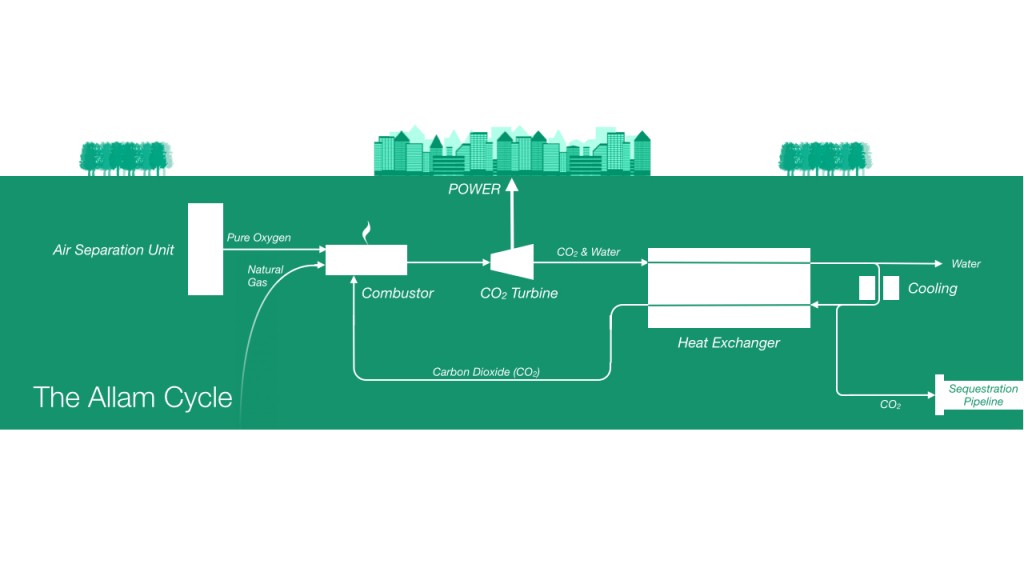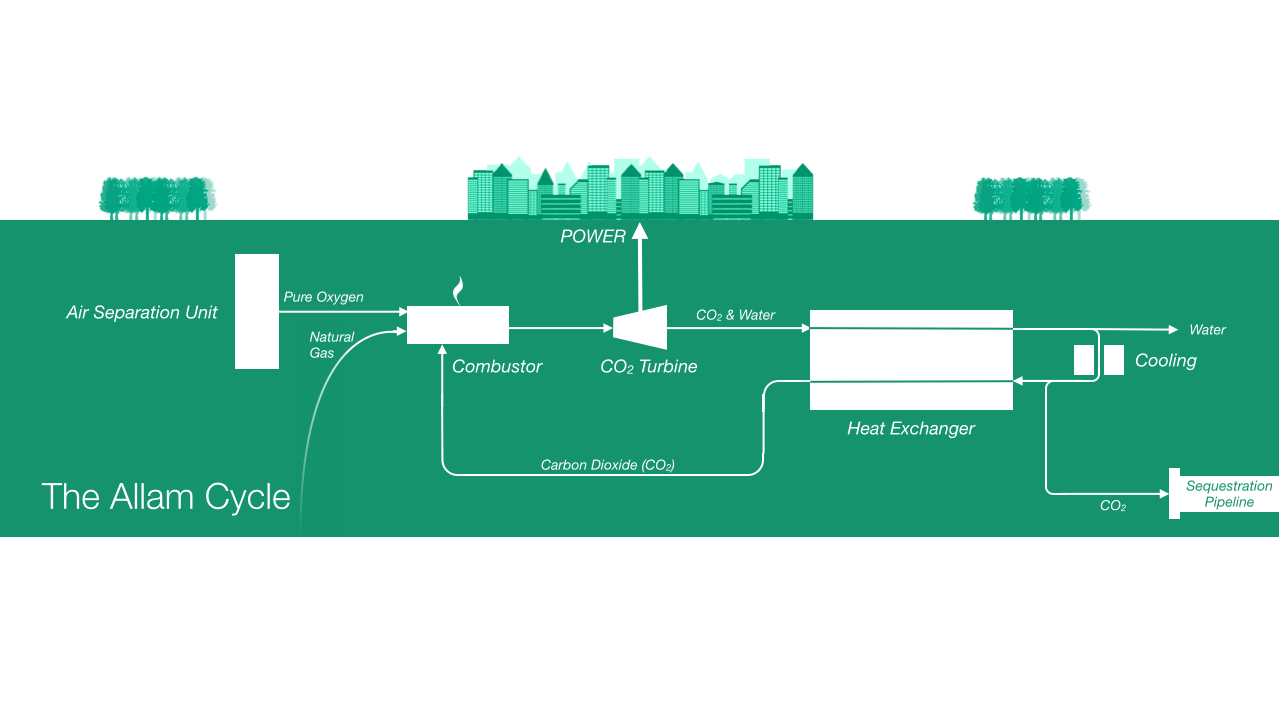November 19, 2014 – The first natural gas power plant that completely captures carbon is about to be constructed by NET Power, a Durham, North Carolina company. The 50 Megawatt facility is being built in Texas and will go online in 2016 at a cost of $140 million U.S.
The zero emission technology used is The Allam Cycle, an oxy-combustion process that separates oxygen from the atmosphere and combines it with natural gas and carbon dioxide (CO2) under high pressure. Other natural gas plants burn fuel in ambient air which is almost 80% nitrogen. This produces an unwanted byproduct, nitrous oxide, a potent greenhouse gas and pollutant.
 Water is the only other byproduct of combustion. It initially is steam and condenses when exiting the combustion chamber. The compressed CO2 is the energy driver. When it leaves the combustion chamber the force created turns the turbine which is attached to a power generator. The used CO2 passes through to a heat exchanger and loops back to the combustion chamber where it can be reused. Any excess pressurized CO2 gets fed into a pipeline to be permanently pumped and sequestered underground.
Water is the only other byproduct of combustion. It initially is steam and condenses when exiting the combustion chamber. The compressed CO2 is the energy driver. When it leaves the combustion chamber the force created turns the turbine which is attached to a power generator. The used CO2 passes through to a heat exchanger and loops back to the combustion chamber where it can be reused. Any excess pressurized CO2 gets fed into a pipeline to be permanently pumped and sequestered underground.
Unlike traditional natural gas power plants there is no gaseous excess outflow or requirement for post-capture of emissions. So no smokestack and no expensive scrubbers. And though water is a byproduct of the process, no water is initially needed which is a good thing in the persistent long-term drought impacting Texas.
NET Power has the ability to substitute natural gas with other fossil fuels, notably coal. Fundamentally a plant burning coal would use the same process with a coal gasifier added to the front end. Traditional coal-fired power plants burn the coal to boil water to produce steam. Using Allam Cycle technology no water is required, and the power plant, using oxy-combustion would produce no nitrous oxide or sulfur dioxide, a common byproduct of traditional coal-burning plants. Testing of different types of coal fuel is ongoing with great preliminary results obtained from burning of both bituminous coal and lignite (brown coal).
For traditional fossil fuel energy companies the technology NET Power has devised could be the answer they seek to ensure that current in-ground assets can still be of value in a low carbon economy. Instead of contributing negatively to climate change, they will finally have a technology that provides the much needed always available energy that is not possible solely relying on solar and wind renewables.


















Sounds interesting; the basic concept seems thermodynamically sound, but it begs a few troubling questions. Atmospheric oxygen is the sole oxidizer. That insures the turbine exhaust is only water vapor and nearly pure CO2. The same would be true with the exhaust of conventional steam boilers, which could use pure oxygen as the sole oxidizer. Commercial sized units, say 250 MWe, whether steam boilers or gas turbines, would need about 3000 tons of LOX per day. So every power plant would need its own medium sized liquid air plant. Producing 3.000 tons of LOX would collaterally produce 12,000 tons of LN2. If very many power plants begin to use pure oxygen in their boilers or gas generators, who is going to buy all that extra LN2 production, and where is all the CO2 going to wind up? Perhaps the “air separation unit” would be highly regenerative and all the LN2 would be used to chill the intake air.
Conventional power plant steam turbines turn at a speed (3000-3600 RPM) that syncs the direct drive alternator cycles with the grid frequency (normally 50-60 HZ). Typical steam turbine maintenance costs are less than ½ cent/kWh, and with conservative and competent operation, service lives can exceed 50 years. Will the Net Power gas turbine turn at 3,600 rpm like a steam turbine, or will it turn at 12,000+ rpm, and hence require expensive and maintenance hungry reduction gearing? To obtain the claimed ~ 60% turbine efficiencies, high RPM, high pressures, and high temperatures are necessary. What will the service life be, and what will maintenance costs be? Then there are questions about the high pressure high temp heat exchanger costs and reliability. I think the Net Power system can work, but I wonder if it will be cost effective. Only running a demonstration plant for years could answer the true costs questions.
Why not just start using pure oxygen with conventional power plant boilers and then just cool and compress the boiler exhaust, which would be pure CO2 and water vapor? If the basic pollution reduction scheme works with a gas turbine, why wouldn’t it work with a steam turbine? Simple inspection suggests free air is a lot cheaper than cryogenic-plant LOX as the combustion oxidizer. Net Power would have us believe their gas turbine system produces enough increase in thermodynamic efficiency to more than pay for the LOX. That might be true, but it’s a very tricky proposition. Private electrical utilities have a good understanding of what they have with their steam turbines, and they won’t be eager to risk their capital switching over to Net Power LOX gas turbines that have a lot of question marks. Governments might compel them to reduce NOx and sequester all carbon, but it seems likely they will want to stay with steam turbines. I’ll bet GE has a lot more clout with governments than Toshiba does.
[…] It uses The Allam Cycle, an oxy-combustion process to drive compressed CO2 in a closed loop that powers a turbine and gets recycled. […]